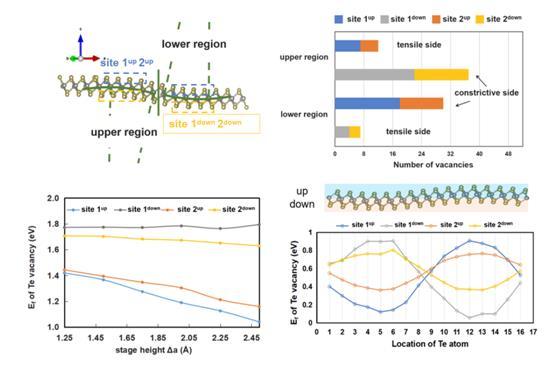Scientists discover new mechanism of symmetry restoration in turbulence
2025-03-13Experimental evidence confirms Bose-Einstein condensation of two-magnon bound state
2025-03-13Cluster structures in beryllium-10 enhance dipole resonance strength
2025-02-25SUSTech researchers develop ambient-pressure nickelate high-temperature superconductors, launching a new phase of superconductivity research
2025-02-18Researchers unveil giant spin-splitting in room-temperature metallic antiferromagnet CrSb
2024-11-20Recently, Associate Professor Junhao Lin’s research group from the Department of Physics at the Southern University of Science and Technology (SUSTech) has published their researches about the large-scale lossless lattice characterization of water-oxygen sensitive 2D materials in Advanced Science. Their paper was entitled “Direct Visualization of large-scale Intrinsic Atomic Lattice Structure and Its Collective Anisotropy in Air-sensitive Monolayer 1T’-WTe2.”

It has been shown that the 2D exhibit excellent physical and chemical properties, which are quite different from those of conventional 3D bulk crystals. The surface morphology and lattice defects greatly affect the material’s external properties. However, under the thickness of a single molecular layer, most 2D materials are very sensitive to oxygen and water molecules in the air, which can easily lead to structural collapse due to oxidative metamorphism. Therefore, maintaining atomic-scale structural integrity and surface cleanliness of sensitive two-dimensional materials has always been an urgent problem to be solved in studying their microstructure.
To overcome this problem, Junhao Lin’ group set up a special glove box interconnected system. The entire process, from the growth, transfer to STEM imaging, is operated in the inert gas environment inside a home-built interconnected glove-box system, entirely isolated from the ambient environment. Such a setting ensures the surface cleanliness and structural integrity of the air-sensitive 2D samples. Based on this system and the high-resolution transmission electron microscopy (HRTEM) with spherical aberration correction by vacuum transfer holder, Junhao Lin’s research group achieved high quality and a large range of lossless lattice atom imaging of sensitive 1T ‘-WTe2 monolayer for the first time (Figure. 1).

Figure 1. Optical and STEM imaging of air-sensitive WTe2 monolayer
After analyzing a wide range of 1T ‘-WTe2 atom images, they found that the lattice tends to have collective distortion along a specific crystal plane direction. The continuous lattice distortion is usually caused by the surface undulation characteristic of two-dimensional materials. In contrast, the continuous extended structure of 1T ‘-WTe2 surface undulation can be reflected by the distortion degree of the quadrilateral element composed of W-Te atoms. Therefore, by recognizing the distortion degree distribution of W-Te quadrilateral elements in a wide range of atomic lattice images, it describes the undulation trend and propagation direction of the ripple structure at the atomic scale (Figure. 2).
Further studies show that in a continuous monolayer, the undulating structure propagates only in the direction perpendicular to the crystal plane (100), (110), or (1-10). It presents great structural anisotropy, which is completely different from the isotropic surface ripples reported in conventional two-dimensional materials such as graphene and MoS2 monolayer.

Figure 2. STEM image of ripples propagating perpendicular to the (110) crystal planes and the corresponding spatial distribution mapping of the distorted quadrilateral units
To further verify the anisotropy of ripples on the surface of monolayer WTe2, the research team designed a TEM diffraction point broadening experiment with biaxial tilting (Figure. 3) to detect structural fluctuations in real space. It is based on the tangent position of the Ewald sphere and the relrods in inverted space, i.e., the broadening of diffraction spots.
In the experiment, the team used a double-tilting rod to achieve two axial rotations, which can detect structural fluctuations in all directions throughout real space. When the axis rotates along the α and β angles, the diffraction points in the corresponding axial direction are not broadened. The lattice constants of the crystal planes without broadened diffraction points (3-30) and (3-60) are constant, while the lattice constants of the crystal planes with broadened points (330) and (360) change dramatically. Therefore, the surface ripples of two-dimensional WTe2 show a strong anisotropic structure. Further analysis by the research team shows that the average ripple height of a single-layer WTe2 surface is about 2.5nm.

Figure 3. Biaxial tilting TEM diffraction pattern experiment
The results of large-scale lossless lattice atomic imaging also led to further exploration in the field of intrinsic defects of WTe2. The anisotropic undulating structure of the WTe2 monolayer surface affects the distribution of Te vacancies. According to the number of Te vacancies at different positions in the primitive cell, Te atoms are more inclined to escape from the contraction side of the ripple structure, showing the inherent anisotropy of their defect distribution (Figure. 4).
This phenomenon can be explained from the perspective of the lowest energy of the first principle calculation. Under the same amount of contraction, compared with the shortening of in-plane bond length, the Te vacancies formation energy of the undulating structure is lower. Moreover, Te vacancies located in the contraction structure inside the curved ripple have lower formation energy. This is because the average atomic spacing in these regions is smaller, the distortion curvature is larger, and it is easier to accumulate Te vacancies.
The research results deepen the understanding of intrinsic lattice and defect structure of sensitive 2D materials at the atomic level. It also helps researchers to further study the atomic-scale structure and property relationship of emerging sensitive 2D materials, laying a solid foundation for defect engineering research of sensitive 2D materials.

This study was completed by Junhao Lin’s group from the Department of Physics at SUSTech, and Feng Pan’s group from Peking University Shenzhen Graduate School (PKU Shenzhen). Kangdi Niu, a Ph.D. student at SUSTech, is the first author of this paper. Professor Feng Pan and Associate Professor Junhao Lin are the co-corresponding authors, while SUSTech was the first affiliation unit of this paper.
This work was supported by the National Natural Science Foundation of China (NSFC), the Guangdong Provincial Innovation Program, the Shenzhen Peacock Program, the University Stable support funds, and the Pico Center of SUSTech.
Paper link: http://doi.org/10.1002/advs.202101563